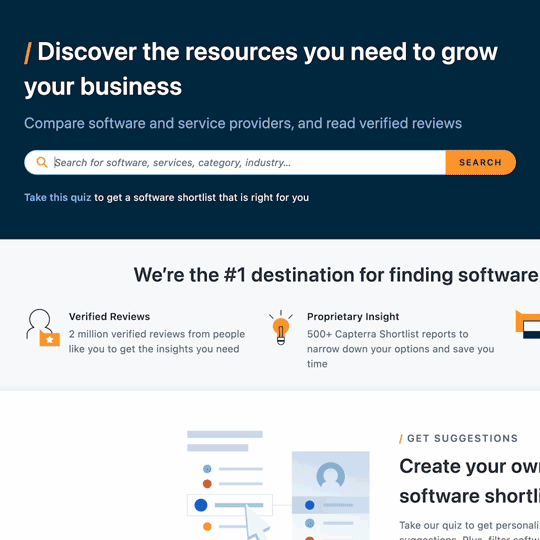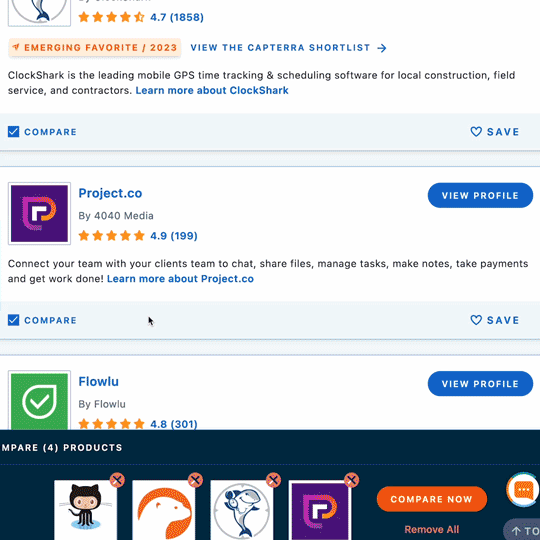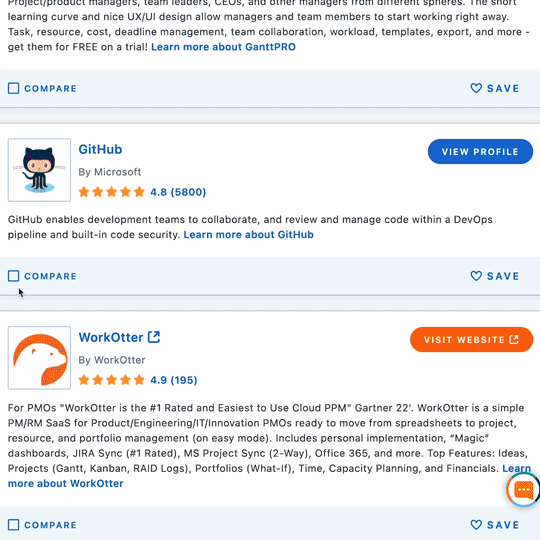Find the right software platform for your business goals, budget, and needs.
Shopping for new software can feel overwhelming. There are so many options to choose from, and when you finally narrow your choices down, you might find yourself worrying about whether you’re making the right choice. What if there is a better choice that simply got lost in the process?
Here at Capterra, we believe that as a small-business leader, decision-maker, and software buyer, you deserve to feel sure that the software you choose is the right one for your business.
Our comparison tool helps you compare competing software platforms against each other. Whether you’re just starting the software buying process and exploring options, or you’re preparing to make your final decision, this tool can make the process a little easier and help you feel as confident as possible in your decision.
What is Capterra’s comparison tool?
Small businesses are accelerating their digital transformation, increasingly investing in new technology and software. And unfortunately, with these new purchases, regret is common.
According to Capterra’s 2023 SMB Tech Trends Survey*, 61% of U.S. SMBs say they have experienced buyer’s remorse over a technology purchase within the past 12 to 18 months.
We developed our comparison tool to help you avoid a similar outcome—you’ll be able to weigh your options, compare and contrast features, and feel like you have what you need to make a fully-informed decision and successfully adopt the right software.
How to use Capterra’s comparison tool to find your best software fit
Step 1: Select a category of software
Capterra has hundreds of software categories to choose from. You can find the category you’re looking for by finding it alphabetically on the list or by typing in the search bar.

GIF that shows user searching for project management software
Step 2: Check the compare box under each product you want to compare
With our comparison tool, you can compare up to four different products, viewing their features and options side-by-side.
Start by selecting the “compare” checkbox under the products you’re considering.

GIF that shows user selecting four project management software options to compare
Step 3: Click ‘see comparison’ to see your results
When you’re finished selecting your options, click the orange “Compare Now” button at the bottom of your screen.
Then, you’ll be able to see information about each of the platforms you selected.

GIF that shows user scrolling through compare page features
Take your time to go through each point of comparison, keeping your business goal and budget in mind:
Pricing: See the starting prices for each of the platforms and whether or not the vendor offers a free trial or free version of the product. Understanding starting costs is the first step to understanding the total cost of ownership.
Best For: Understand how many users the platform is recommended for, as well as which teams would likely benefit the most from its features.
Recognition: What has each platform been celebrated for? Accolades can give you insight into both how users feel about the product and working with the vendor.
Screenshots: Browse screenshots and/or videos of the software’s interface. This will give you a feel for what its user experience may be like.
Features: View what the platform offers. This section lists all of the common features for the given category. Those with a green check mark are what the platform offers. Make sure your chosen platform offers all of the features your business needs.
Reviews: What were other users’ experiences like? This section allows you to read reviews and see scores based on ease of use, customer support, features, and value for your money.
Pros and cons: Read two recent pros and cons shared by real users to get a sense of what the platform does well and where there might be room for improvement.
Deployment and support: Consult this section to learn about how the platform is deployed (e.g., on-premise, cloud, compatibility with Mac, Windows, Linux, as well as mobile-friendliness). Also see what types of support the vendor offers (e.g., chat, 24/7 representative, email help desk, forum, etc.) and the level of training you can expect in the integration process (e.g., in-person, virtual, webinars, videos, etc.).
Alternatives: If the four products you chose don’t meet all of your business needs, consider checking the products in the alternatives sections. These products may offer more of what you need.
Company details: Learn more about your vendor, including where the company is based and when it was founded.
Are you not sure what kind of software you’re looking for?
If you don't know which type of software you need, take a few steps back to consider the business problem you’re looking to address.
Consider these five areas for potential improvement through software[1]:
1. Automation: Are there any processes, such as scheduling or follow-up marketing emails, that could be automated?
Browse Email Marketing Software
2. Business process management: Could your different department teams benefit from a common tool? For example, perhaps all of your teams could benefit from a project management tool or chat software. This can help foster collaboration between teams, coordinate cross-departmental workflows, and reduce app sprawl.
Browse Project Management Software
3. Tracking metrics/progress toward goal: Are you having difficulty proving a positive return on campaigns? Many types of software, such as CRM software, can track important metrics that are critical to understanding a campaign’s success.
Browse CRM Software
4. Ask your employees: Always include employees and other stakeholders in the software buying process. It should be a collaborative effort, not a solo one. Perhaps they need something specific for their workflows, or perhaps they have suggestions for how to make the onboarding process for new employees stronger.
Browse Human Resource Software
5. Collect customer feedback: Ask your customers for feedback about marketing and customer service to make sure you’re meeting their needs.
Browse Help Desk Software
Once you know your software category, you can begin researching options to create a shortlist of one to four products.
Compare options today for a more confident decision in the future
Give our comparison tool a test run by starting your own shortlist of products or looking at the one we’ve put together of project management tools. If you ever want to save your results, you can click on the share button at the top of the page and select “Send this comparison chart to my inbox.”

Click on the Share button and the email icon to save your results

Enter your email address to have your results sent to your inbox
